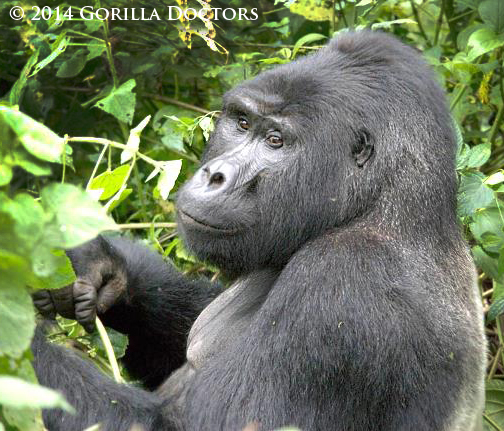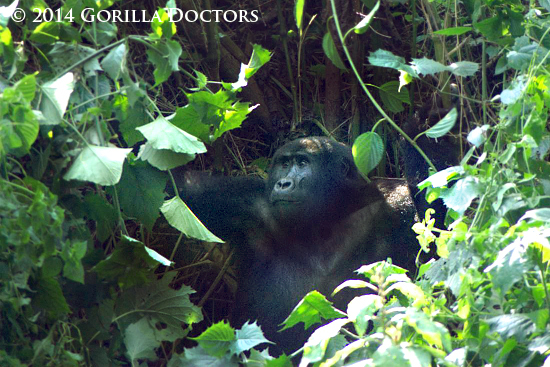Silverback Mishaya’s Unexpected Death, Group Soldiers On
By Gorilla Doctors Staff on Tuesday, February 18th, 2014 in Blog.By Dr. Fred Nizeyimana
Dominant silverback Mishaya in Uganda’s Bwindi Impenetrable National Park was found dead on the morning of February 3rd, 2014 by UWA trackers on patrol in the forest. At just 28-years-old, Mishaya was otherwise a strong and healthy silverback, with no history of illness, no evidence of injury or previous medical interventions and his sudden death was impossible to explain without further investigation.
 Dominant silverback Mishaya in Bwindi Impenetrable National Park, Uganda.
Dominant silverback Mishaya in Bwindi Impenetrable National Park, Uganda.
I conducted a necropsy, along with Drs. Noel and Jan the following day, in the Bubare area of the forest where his body was found in sternal recumbency. Mishaya’s former group members were lingering nearby, but there were no signs of disease within the group. The area of the forest was filled with giant ferns, on steep terrain. Conducting a necropsy can be a challenge when the body is not recovered from the forest [as is required in Uganda], but we were able to thoroughly examine the silverback and determine the cause of his unexpected death: Mishaya had a 360 degree torsion of the intestines that likely killed him within 24 hours.
The small intestine was severely strangulated around the root of the mesentery. There were associated hemorrhages and congestion in the mesentery and intestines, as well as mechanical obstruction. The small intestine was distended with gas, the colon had a small amount of firm feces and the rectum was completely empty. This was indicative of complete failure of intestinal/bowel movements. The small intestine torsion led to vascular congestion, gastrointestinal stasis, accumulation of gas. Death in Mishaya’s case can be attributed to circulating toxins produced by the ischemia and/or intestinal bloat leading to heart failure. Samples were collected for histopathology and toxicological analysis.
Small intestinal torsion has been reported in several mammalian species including humans, but to our knowledge has not been reported in mountain gorillas. The cause is difficult to determine in most cases and in humans, this is a life-threatening condition requiring emergency surgery.
I conducted a routine health check of Mishaya group just one week prior to the silverback’s unexpected death and upon visual examination, the male did not show any sign of ill-health. Mishaya led a group of 10 individuals, comprised mostly of adult females with infants, juveniles and one blackback. The dominant silverback’s death posed a threat to the group, as there is no other mature male within the group to assume the leadership role. All infants would be at risk for infanticide by silverbacks ranging nearby, eager to acquire their own females and bring them into estrus to sire their own offspring.
Surprisingly, blackback Mwine has managed to fill the leadership role in Mishaya group for the time being, keeping the females together and the infants safe.
 Blackback Mwine has taken on the leadership role after dominant silverback Mishaya’s death.
Blackback Mwine has taken on the leadership role after dominant silverback Mishaya’s death.
I visited the group on February 16th to assess their health and tracked the group as they moved quickly through thick vegetation, dominated by Archonia trees, up and over many hills. The group was moving fast until finally settling down to feed in the Mburamaizi ravine to feed. Blackback Mwine chest-beat frequently at our presence, but settled down after some time. Infant Birungi was playing and swinging from branches during the observation. The newest member of the group, an infant born to adult female Mwiza in January 2014, appeared to be in good health, as did the other members of the group. Both UWA trackers and Gorilla Doctors will continue to monitor this group closely.
You can follow the Gorilla Doctors health monitoring efforts on our Facebook page, where we post photos and notes from our monthly visits.
Please consider supporting us by making a secure online donation. Every dollar you give goes to directly supporting our gorilla health programs and One Health initiative. Thank you for your generosity.


 Donate
Donate